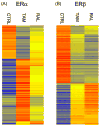Cell type- and estrogen receptor-subtype specific regulation of selective estrogen receptor modulator regulatory elements
- PMID: 19059307
- PMCID: PMC3420066
- DOI: 10.1016/j.mce.2008.10.050
Cell type- and estrogen receptor-subtype specific regulation of selective estrogen receptor modulator regulatory elements
Abstract
Selective estrogen receptor modulators (SERMs), such as tamoxifen and raloxifene can act as estrogen receptor (ER) antagonists or agonists depending on the cell type. The antagonistic action of tamoxifen has been invaluable for treating breast cancer, whereas the agonist activity of SERMs also has important clinical applications as demonstrated by the use of raloxifene for osteoporosis. Whereas the mechanism whereby SERMs function as antagonists has been studied extensively very little is known about how SERMs produce agonist effects in different tissues with the two ER types; ERalpha and ERbeta. We examined the regulation of 32 SERM-responsive regions with ERalpha and ERbeta in transiently transfected MCF-7 breast, Ishikawa endometrial, HeLa cervical and WAR-5 prostate cancer cells. The regions were regulated by tamoxifen and raloxifene in some cell types, but not in all cell lines. Tamoxifen activated similar number of regions with ERalpha and ERbeta in the cell lines, whereas raloxifene activated over twice as many regions with ERbeta compared to ERalpha. In Ishikawa endometrial cancer cells, tamoxifen activated 17 regions with ERalpha, whereas raloxifene activated only 2 regions, which might explain their different effects on the endometrium. Microarray studies also found that raloxifene regulated fewer genes than tamoxifen in U2OS bone cancer cells expressing ERalpha, whereas tamoxifen was equally effective at regulating genes with ERalpha and ERbeta. Our studies indicate that tamoxifen is a non-selective agonist, whereas raloxifene is a relative ERbeta-selective agonist, and suggest that ERbeta-selective SERMs might be safer for treating clinical conditions that are dependent on the agonist property of SERMs.
Figures






Similar articles
-
Estradiol and selective estrogen receptor modulators differentially regulate target genes with estrogen receptors alpha and beta.Mol Biol Cell. 2004 Mar;15(3):1262-72. doi: 10.1091/mbc.e03-06-0360. Epub 2003 Dec 29. Mol Biol Cell. 2004. PMID: 14699072 Free PMC article.
-
Differential regulation of native estrogen receptor-regulatory elements by estradiol, tamoxifen, and raloxifene.Mol Endocrinol. 2008 Feb;22(2):287-303. doi: 10.1210/me.2007-0340. Epub 2007 Oct 25. Mol Endocrinol. 2008. PMID: 17962382 Free PMC article.
-
Estrogen and the selective estrogen receptor modulator (SERM) protection against cell death in estrogen receptor alpha and beta expressing U2OS cells.Mol Cell Endocrinol. 2008 Jul 16;289(1-2):38-48. doi: 10.1016/j.mce.2008.03.005. Epub 2008 Mar 25. Mol Cell Endocrinol. 2008. PMID: 18455292
-
Molecular mechanisms of estrogen action: selective ligands and receptor pharmacology.J Steroid Biochem Mol Biol. 2000 Nov 30;74(5):279-85. doi: 10.1016/s0960-0760(00)00104-7. J Steroid Biochem Mol Biol. 2000. PMID: 11162936 Review.
-
Selective estrogen receptor modulators: mechanism of action and clinical experience. Focus on raloxifene.Reprod Fertil Dev. 2001;13(4):331-6. doi: 10.1071/rd00109. Reprod Fertil Dev. 2001. PMID: 11800172 Review.
Cited by
-
Resistance to antiestrogen arzoxifene is mediated by overexpression of cyclin D1.Mol Endocrinol. 2009 Sep;23(9):1335-45. doi: 10.1210/me.2008-0268. Epub 2009 May 28. Mol Endocrinol. 2009. PMID: 19477949 Free PMC article.
-
Allosteric modulators of steroid hormone receptors: structural dynamics and gene regulation.Endocr Rev. 2012 Apr;33(2):271-99. doi: 10.1210/er.2011-1033. Epub 2012 Mar 20. Endocr Rev. 2012. PMID: 22433123 Free PMC article. Review.
-
Cyclopia extracts act as ERα antagonists and ERβ agonists, in vitro and in vivo.PLoS One. 2013 Nov 4;8(11):e79223. doi: 10.1371/journal.pone.0079223. eCollection 2013. PLoS One. 2013. PMID: 24223909 Free PMC article.
-
Set-based joint test of interaction between SNPs in the VEGF pathway and exogenous estrogen finds association with age-related macular degeneration.Invest Ophthalmol Vis Sci. 2014 Jul 11;55(8):4873-9. doi: 10.1167/iovs.14-14494. Online ahead of print. Invest Ophthalmol Vis Sci. 2014. PMID: 25015356 Free PMC article.
-
Characterization of an Estrogen Receptor α-Selective 18 F-Estradiol PET Tracer.World J Nucl Med. 2024 Jun 18;23(3):153-160. doi: 10.1055/s-0044-1786518. eCollection 2024 Sep. World J Nucl Med. 2024. PMID: 39170834 Free PMC article.
References
-
- Beissbarth T, Speed TP. GOstat: find statistically overrepresented gene ontologies within a group of genes. Bioinformatics. 2004;20:1464–1465. - PubMed
-
- Carroll JS, Liu XS, Brodsky AS, Li W, Meyer CA, Szary AJ, Eeckhoute J, Shao W, Hestermann EV, Geistlinger TR, Fox EA, Silver PA, Brown M. Chromosome-wide mapping of estrogen receptor binding reveals long-range regulation requiring the forkhead protein FoxA1. Cell. 2005;122:33–43. - PubMed
-
- Cummings S, Eckert S, Krueger K, Grady D, Powles T, Cauley J, Norton LTN, Bjarnason N, Morrow M, MEL, Black D, Glusman J, Costa A, Jordan V. The effect of raloxifene on risk of breast cancer in postmenopausal women. JAMA. 1999;281:2189–2197. - PubMed
-
- Dahlman-Wright K, Cavailles V, Fuqua SA, Jordan VC, Katzenellenbogen JA, Korach KS, Maggi A, Muramatsu M, Parker MG, Gustafsson JA. International union of pharmacology. LXIV Estrogen receptors. Pharmacol Rev. 2006;58:773–781. - PubMed
-
- Dudoit S, Shaffer JP, Boldrick JC. Multiple hypothesis testing in microarray experiments. Stat Sci. 2003;18:71–103.
Publication types
MeSH terms
Substances
Grants and funding
LinkOut - more resources
Full Text Sources
Other Literature Sources

